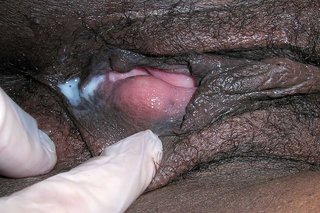Bartholin's cysts usually affect women aged between 20 and 50 years. They can affect anyone with a vagina.
Check if it's a Bartholin's cyst
The main symptom of a Bartholin’s cyst is a soft lump on 1 side near the opening of your vagina. It can be small and painless and may not cause any symptoms.
A Bartholin’s cyst can range in size, from the size of a pea to the size of a golf ball. Other symptoms can include:
- discomfort or pain in the area surrounding your vagina (vulva) when you walk, sit down, or have sex
- 1 side of your vaginal lips looking larger or swollen
If the cyst becomes infected, it may turn into an abscess. Symptoms include:
- smelly discharge from the abscess
- feeling unwell, or having a high temperature
- intense pain around the abscess
A Bartholin’s cyst can sometimes be found during routine examinations like cervical screening (smear test).
See what a Bartholin's cyst looks like

Non-urgent advice: See a GP if:
- you have a lump in or around your vagina
Urgent advice: Get an urgent GP appointment or call 111 if:
You have a lump in or around your vagina and:
- it gets bigger and more painful within hours or days
- there is pus in the lump
- you feel unwell or have a high temperature
- the lump becomes tender, swollen, hot and red – redness may be harder to see on black or brown skin
These could be signs of an infected Bartholin’s cyst (abscess).
You can call 111 or get help from 111 online.
What happens at the GP appointment
The GP will look at the lump to check if it’s a Bartholin’s cyst.
Let them know if you'd like someone else to be in the room with you (a chaperone) – this could be someone you know, a nurse or a trained member of staff.
If the GP is not sure what’s causing the lump, they may refer you for further tests.
Things you can do to treat a Bartholin's cyst
If you've been diagnosed with a Bartholin's cyst it will often go away by itself without treatment. But there are things you can do to help relieve discomfort or pain.
Do
-
sit in a bath with warm water a few times a day, for 3 to 4 days
-
dip a cloth or cotton wool in warm water and hold it gently on the cyst
-
take ibuprofen or paracetamol to help with pain
Don’t
-
do not try to squeeze or drain the fluid from a Bartholin’s cyst yourself, as this can cause infection
What to do if a Bartholin's cyst bursts
If a Bartholin’s cyst bursts on its own, this is OK and should ease the pain. Keep the area clean and dry to help stop infection.
Treatment for a Bartholin’s cyst
If you have an infected Bartholin's cyst, you’ll be offered antibiotics.
If antibiotics do not work, or the cyst keeps coming back, you may need a surgical procedure to drain it.
Draining a Bartholin's cyst may be done under local anaesthetic where you'll be awake during the procedure, or with a general anaesthetic where you'll be asleep.
The procedure involves making a cut in the cyst. The doctor may leave a small opening so fluid can drain out, or insert a small, thin tube (catheter) into the cyst. You’ll usually have the catheter in for around 4 weeks before it is removed.
During the procedure, the doctor may take some fluid from the lump to test for infection.
What causes a Bartholin’s cyst
A Bartholin’s cyst happens when small glands in the vagina become blocked. It's often not known why the glands become blocked.
If a Bartholin’s cyst becomes infected, this can cause an abscess. A Bartholin’s abscess may be caused by infections, including sexually transmitted infections (STIs) such as gonorrhoea or chlamydia.
Page last reviewed: 23 April 2025
Next review due: 23 April 2028